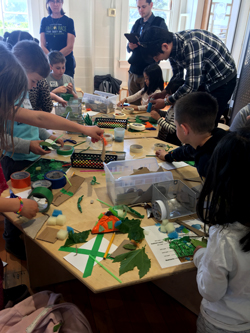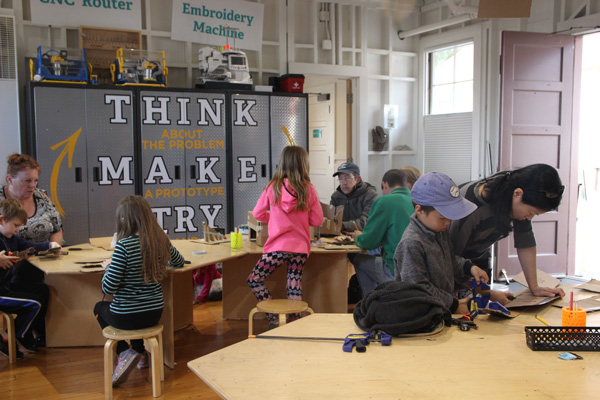Exploring the Engineering Design Process with the Girl Scouts of Northern California
by Madeleine Crow, Corporate and Foundation Relationship Manager, Bay Area Discovery Museum | June 26, 2019
The Bay Area Discovery Museum (BADM)'s mission is to transform research into early learning experiences that inspire creative problem solving. Its work is carried out across its 7.5-acre museum, and is the driving force behind permanent and temporary exhibits, daily STEM and art programs, themed special events, and school and community programs.
The Bay Area Discovery Museum (BADM) is a hands-on learning space that is open to all children. We are constantly looking for opportunities to deepen our impact throughout the Bay Area, and give children the chance to discover new interests, dive deeper into something they love, and have fun exploring early learning concepts.
As the result of receiving an Infy Maker Award from Infosys Foundation USA in 2018, BADM, in partnership with the Girl Scouts of Northern California (GSNORCAL), was able to support three Girl Scout Mechanical Engineering badge programs in our Fab Lab makerspace. BADM opened the world’s first early childhood Fab Lab in May 2016, and the exhibit has become the center of science, technology, engineering, and math (STEM) learning on BADM’s campus.

With guidance and support from GSNORCAL, BADM Fab Lab educators designed and led three workshops in 2018 and 2019 for 75 Brownie Girl Scouts in second and third grades from underserved Bay Area communities.
In each workshop, the Girl Scouts completed creative projects designed by BADM educators to engage the girls with important engineering concepts, which in turn earned them one badge.
In Fling Flyer, scouts used tablets to design their own flying machines, which were then brought to life using the Fab Lab's laser cutter. The girls learned about the physics involved in building a functioning flying machine by testing variables like wing span and body shape, and observing how the changes impact how far their prototypes could fly. Completing this program earned scouts their Gliders/Forces of Light badge.
In Leap Bots, the scouts and their chaperones used BADM’s engineering design process Think, Make, Try® to design and build spring-powered creations. They use d a range of high and low-tech tools—including hand tools, power tools, tablets, and laser cutters—and observed how using different springs could impact the jump height of their creations. Completing this program earned scouts their Projectiles/Potential Energy badge.
In Racer Car, scouts explored the concepts of gravity and physics. After using tablets and laser cutters to design and build custom racing cars, the girls tested their cars’ speed on a series of ramps. Experiments with weights and other elements allowed them to make decisions on how to adjust their design in order to improve how fast their car could go. Completing this program earned scouts their Gravity and Friction badge.
Once the facilitated program ended, girls were free to explore the rest of the museum. During this time, adult chaperones and troop leaders stayed behind to participate in a training on how best to provide engaging and developmentally-appropriate STEM challenges for their troops.

One of the key components of this professional development was introducing and familiarizing adult leaders with BADM's three-step engineering process, Think, Make, Try. Think, Make, Try empowers children to solve creative challenges by thinking about the problem, making a prototype, and trying what they’ve made. During the 'Try' phase, children are prompted to evaluate what works about their original design, and what could be improved upon. They return to the ‘Think’ phase to brainstorm how to adjust their prototype, then ‘Make’ the changes before trying their design again.
It was important to the overall partnership between BADM and GSNORCAL that adult leaders feel comfortable implementing Think, Make, Try® in various situations with their troops. Even after their time at BADM had ended, the experience they had and the skills they learned would extend far beyond the museum’s walls.
For the BADM educators, it's important to better understand how to make the STEM-based maker programming in the Fab Lab more accessible, not only across socio-economic lines, but also across ages and levels of interest. While the end product is often most exciting, the BADM engineering process.
It was also critical for the museum's educators to learn more about the pain points adults feel when trying to share age-appropriate STEM learning. Across BADM's on-site and off-site STEM programs, adult-child engagement is one of the most important indicators of success. Being able to have an open dialogue with adults who are charged with making this type of learning appropriate and exciting for young children is a valuable way that we learn how to best design the programming we offer at the museum and throughout the Bay Area.
The work that we did with the support of the Infosys Foundation USA and its Infy Maker Award has had tremendous ripple effects. It not only enabled us to welcome 75 Girl Scouts, their leaders, and adult chaperones to our site, it will inform the programming that we offer to all of our on-site visitors, students, children, and families throughout our community.

